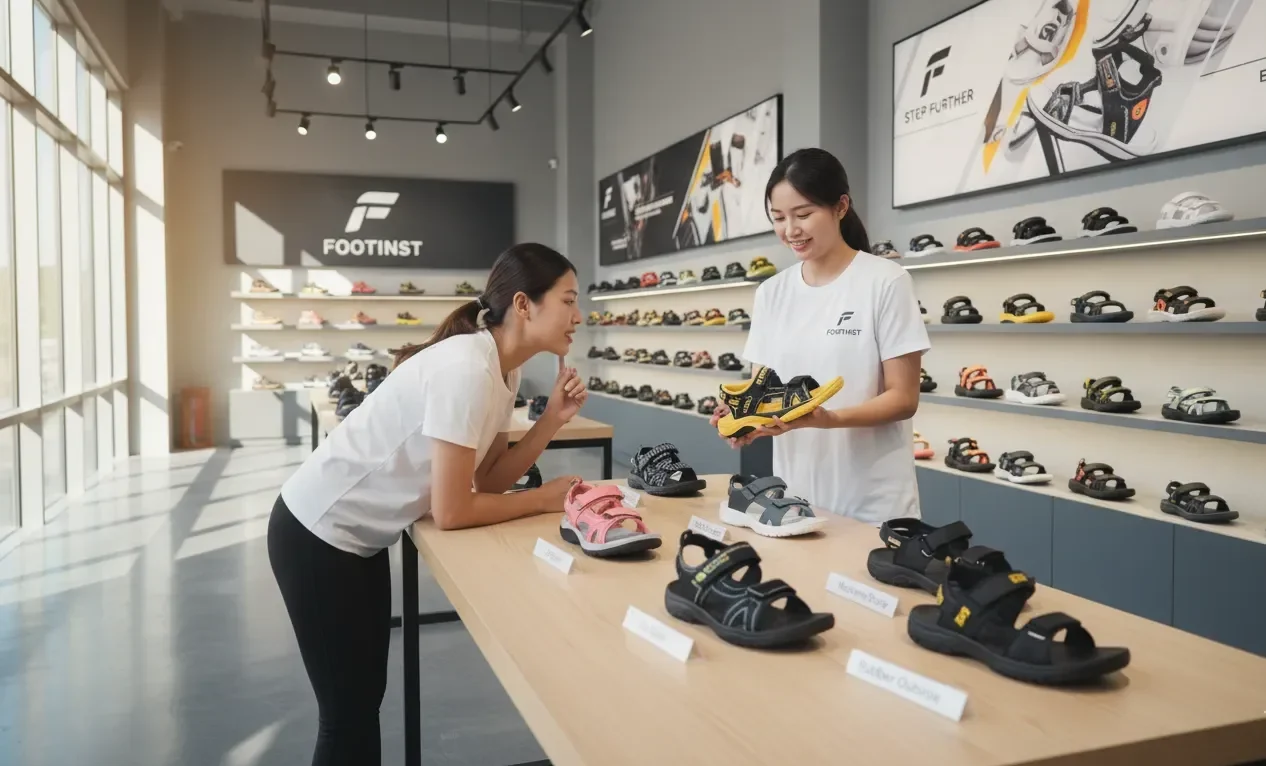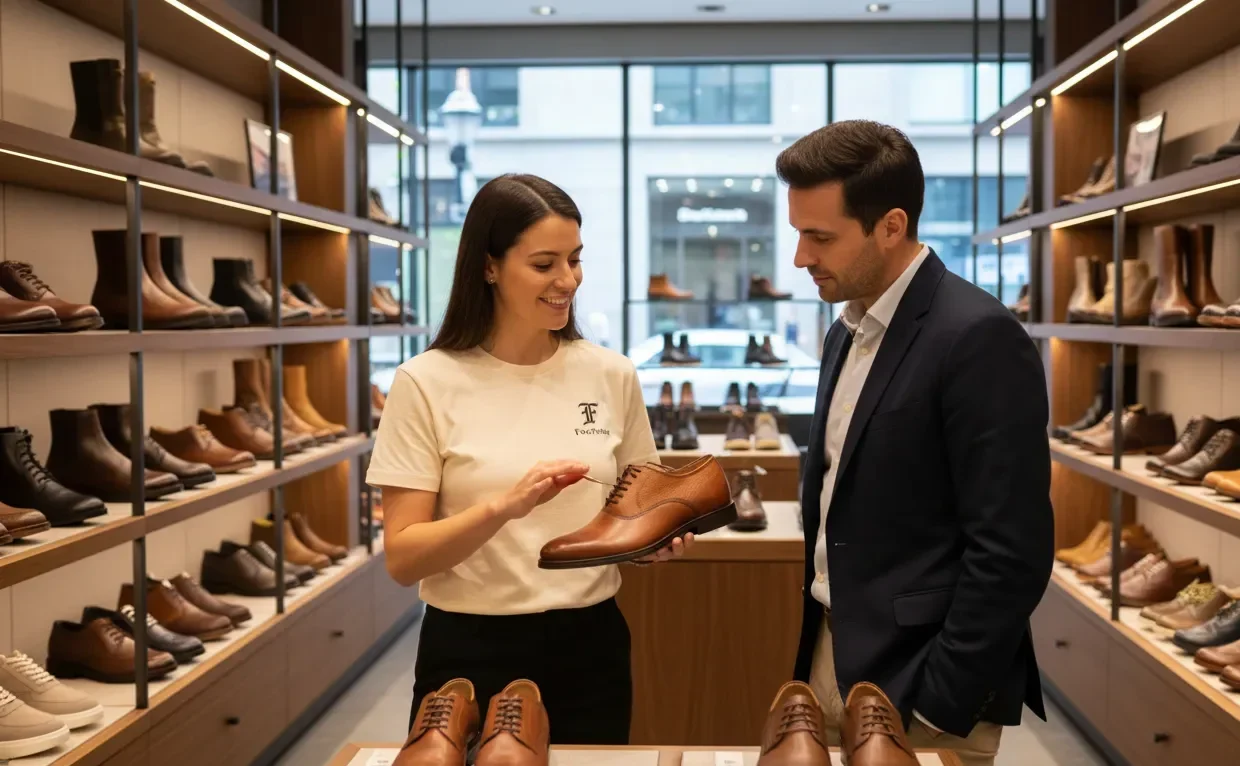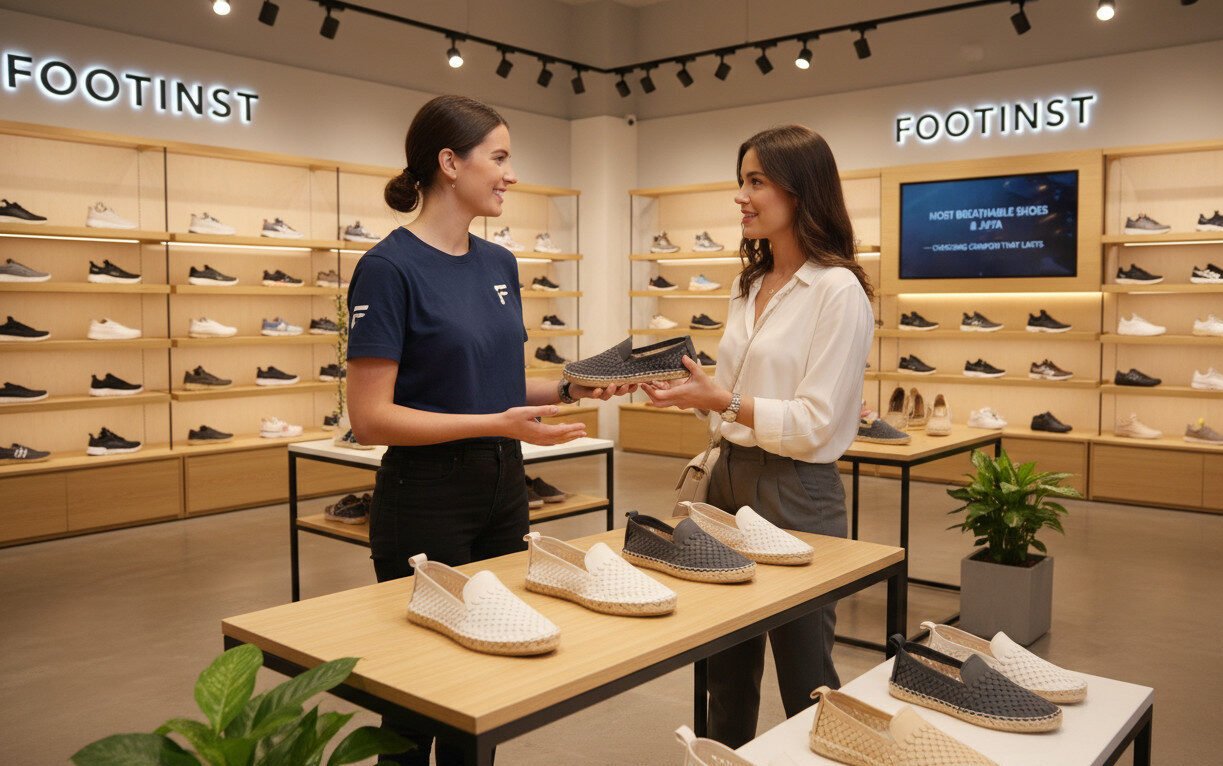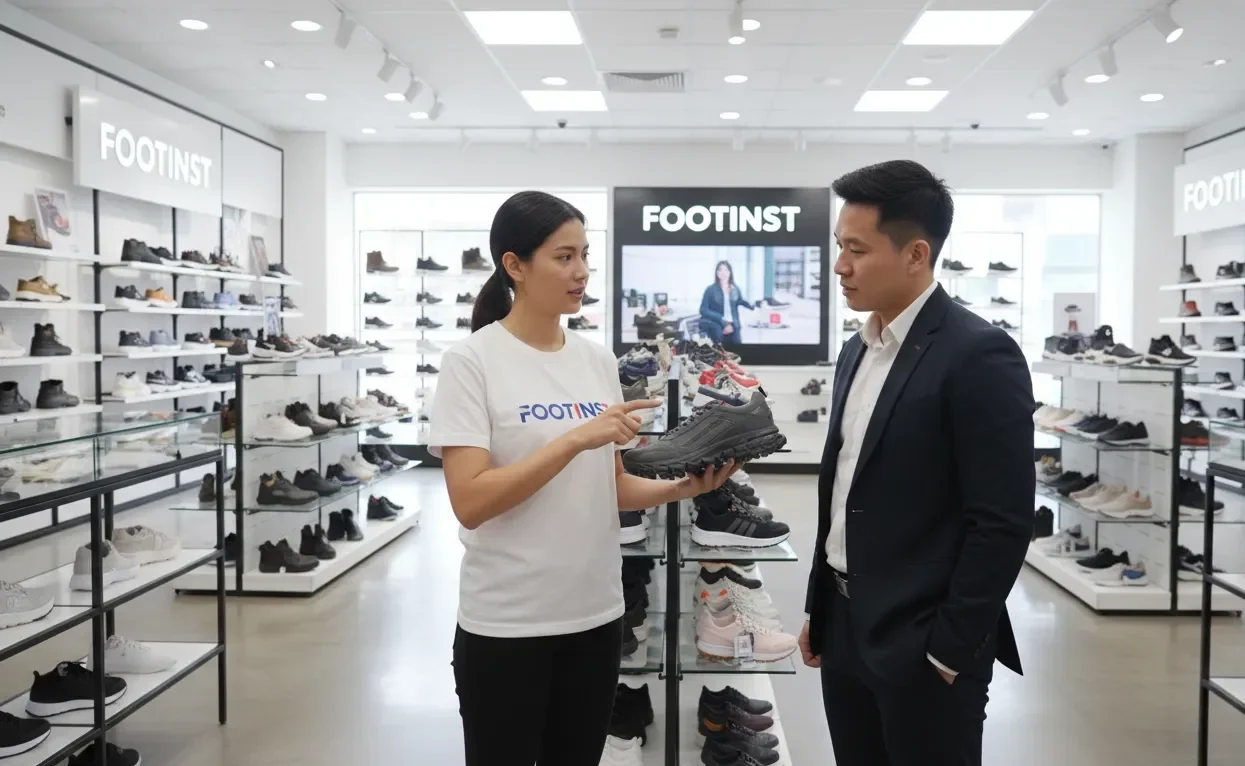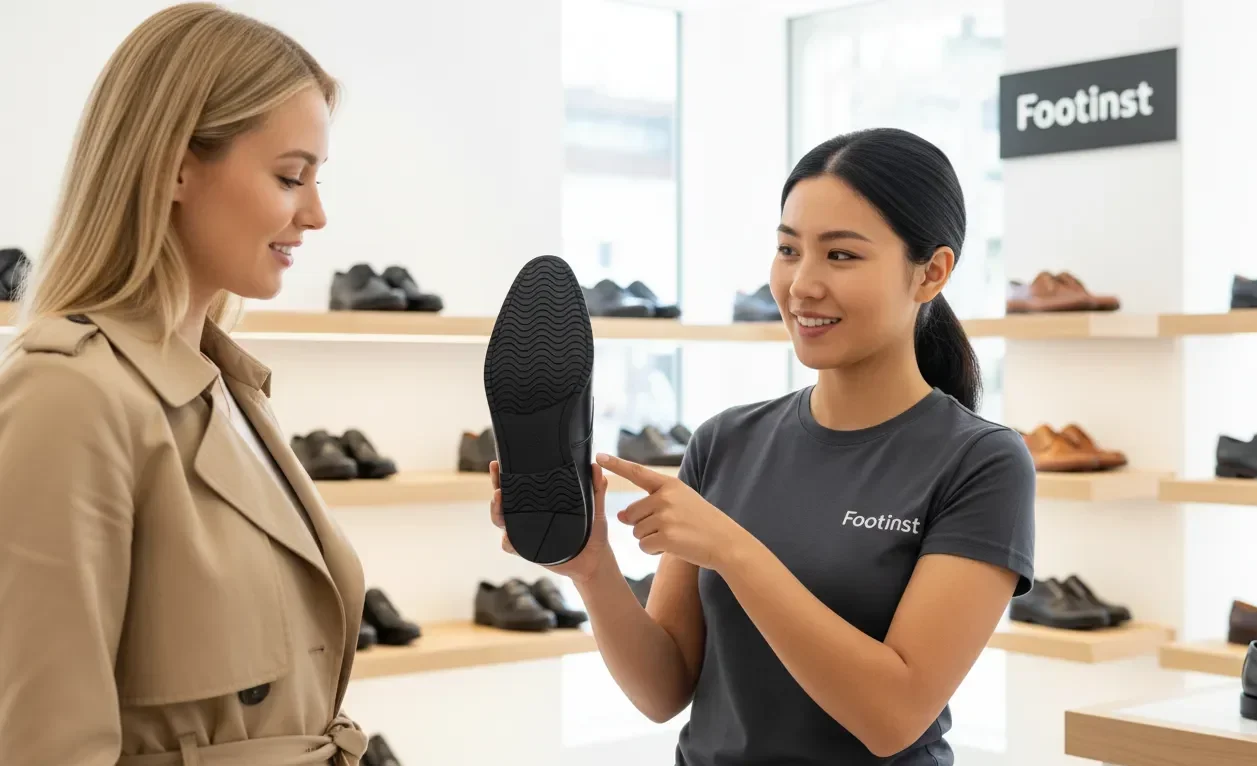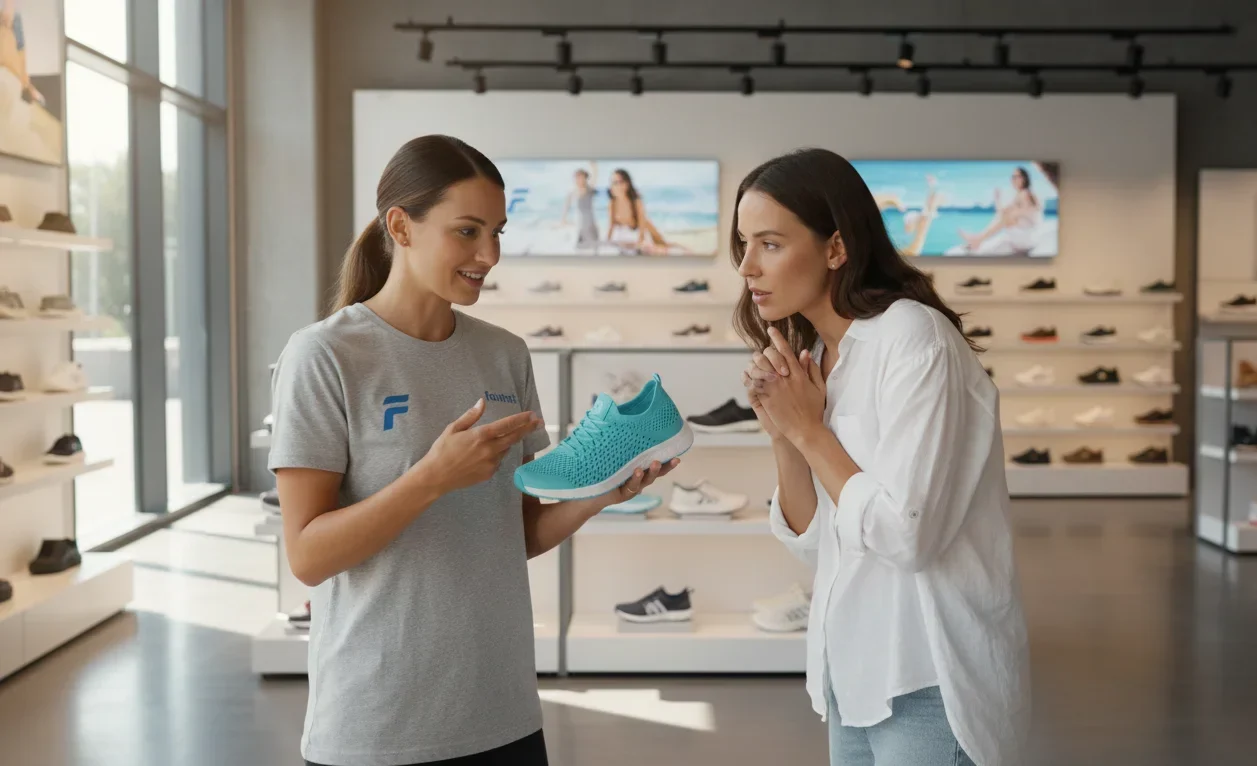Best Shoes for Flat Feet – Expert Tips, Comfort, and Daily Support
Flat Feet Need Special Shoes
Flat feet, also called fallen arches, affect millions worldwide. While it may seem minor, choosing the wrong shoes can lead to pain, fatigue, and long-term foot issues. From real store experience, customers with flat feet often struggle with comfort and support, especially when walking or standing for long hours.
Expert Insight:
- Flat feet reduce natural arch support, which can lead to overpronation (feet rolling inward) and stress on knees, hips, and lower back.
- Choosing supportive shoes is not just about comfort, it prevents chronic pain and improves posture.
Problem-Solving Tips:
- Prioritize shoes with built-in arch support or removable orthotic insoles for customization.
- Rotate shoes daily to reduce fatigue and wear.
- Avoid flat, thin-soled shoes that offer no support, even if they look stylish.
Friendly Advice:
- Many buyers think any cushioned shoe works—but cushioning alone isn’t enough. Look for proper arch support, stability, and a snug yet flexible fit.
- Remember, even everyday casual shoes matter; your feet experience hours of impact daily.
Practical Example:
- In-store, customers often try two sizes or brands. Those who test for both arch comfort and heel stability usually leave satisfied and pain-free.
Flat Feet – Causes, Symptoms, and Challenges
Flat feet might seem simple, but from real store experience, understanding the condition helps in selecting the right shoes for long-term comfort and support.
1. Causes of Flat Feet
- Genetics: Many customers inherit flat arches from parents.
- Weak Arches or Ligaments: Over time, arches can collapse due to weak ligaments or muscles.
- Injury or Trauma: Accidents affecting the foot or ankle may flatten the arch.
- Medical Conditions: Diabetes, obesity, or arthritis can influence foot structure.
2. Common Symptoms
- Pain in feet, ankles, or lower legs after long walking.
- Swelling along the inside of the ankle.
- Shoes wear unevenly, especially on the inner sole.
- Difficulty standing on tiptoes or experiencing foot fatigue quickly.
3. Challenges for Shoe Selection
- Lack of Arch Support: Standard shoes often fail to provide proper support, causing discomfort.
- Stability Issues: Flat feet can lead to overpronation, affecting balance and gait.
- Style vs Comfort: Many buyers prioritize style but end up sacrificing support, leading to pain.
Real Store Insight
- Customers who explain their daily activity level (office, walking, sports) receive better guidance for shoe selection.
- Shoes that offer flexible yet firm arch support and cushioned heels are usually top picks at Footinst flagship stores.
Problem-Solving Tips
- Test shoes by walking on both soft and hard surfaces in-store to feel support.
- Choose shoes with removable insoles to add custom orthotics if needed.
- Rotate between shoes with different arch support levels to prevent fatigue.
— Expert Advice from Footinst Team
Key Features to Look for in Shoes for Flat Feet
Selecting the right shoes for flat feet is crucial for comfort, posture, and long-term foot health. From real store experience, customers who focus on key shoe features rarely face pain or fatigue.
1. Arch Support
- Look for built-in arch support to reduce overpronation.
- Removable insoles allow custom orthotics for personalized support.
2. Cushioning & Shock Absorption
- Soft midsole materials (EVA, memory foam, or gel) absorb impact and reduce stress on knees and back.
- Avoid overly soft soles that sag easily, as they reduce stability.
3. Heel Stability
- A firm heel counter keeps the foot aligned and prevents inward rolling.
- Moderate heel height (around 1–1.5 inches) supports natural foot posture.
4. Flexibility vs Rigidity
- Shoes should be flexible at the forefoot for walking comfort.
- Avoid shoes that are too stiff, which restrict natural foot movement.
5. Proper Width & Fit
- Flat feet often require slightly wider shoes to prevent pinching.
- Ensure enough room in the toe box for natural toe splay.
6. Traction & Outsole
- Non-slip rubber outsoles reduce accidental slips, especially for active or older customers.
- Durable outsoles extend shoe life, providing long-term value and comfort.
Real Store Insight
- Customers often choose shoes after walking in them 5–10 minutes to feel arch support and cushioning.
- Shoes with removable insoles are consistently recommended for flat feet buyers.
Problem-Solving Tips
- Test shoes on both carpeted and hard surfaces to ensure proper support.
- Rotate between two pairs of supportive shoes to avoid fatigue and excessive wear.
- Consider orthotic-friendly models if you already use custom insoles.
— Expert Advice from Footinst Team
Best Types of Shoes for Flat Feet – Casual, Dress, and Sports
Choosing shoes for flat feet isn’t just about comfort—it’s about matching your lifestyle while protecting your arches. From real store experience, different activities require different shoe types.
1. Casual Shoes
- Sneakers & Walking Shoes: Offer cushioned midsoles and flexible soles.
- Slip-ons & Loafers: Look for models with arch support inserts.
- Practical Tip: Neutral colors often pair well with most outfits and encourage daily wear without sacrificing support.
2. Dress Shoes
- Derbies & Oxfords: Choose those with built-in arch support and cushioned insoles.
- Loafers: Opt for loafers with a slightly elevated heel to reduce strain on flat arches.
- Problem-Solving Tip: Many buyers avoid dress shoes fearing discomfort; choosing orthotic-friendly models ensures both style and comfort.
3. Sports & Active Shoes
- Running Shoes: Prioritize stability and motion control features to counter overpronation.
- Training Shoes: Cushioned midsoles and firm heel counters help in cross-training, gym, or aerobics.
- Practical Example: In-store, active customers often test running shoes on treadmills to feel arch support and midsole responsiveness.
Real Store Insight
- Customers with flat feet often rotate two or three types of shoes for work, casual outings, and sports to avoid fatigue.
- Those who try shoes with and without removable insoles can better decide if they need custom orthotics.
Problem-Solving Tips
- Always check heel alignment and arch support by standing barefoot, then in the shoes.
- If a shoe feels too soft, consider adding a thin supportive insole for daily wear.
- Avoid shoes with flat, hard soles for extended walking or standing.
— Footinst Expert Advice
Arch Support & Insoles – Making Every Step Comfortable
For flat feet, proper arch support is the cornerstone of comfort. From real store experience, customers who focus on insoles rarely complain about pain or fatigue.
1. Built-In Arch Support
- Many modern shoes come with contoured footbeds designed to support flat arches.
- Firm arch support prevents overpronation and reduces stress on knees and back.
2. Removable & Custom Insoles
- Shoes with removable insoles allow the use of orthotics or specialized inserts.
- Custom insoles can correct posture, improve comfort, and reduce foot fatigue.
- Practical Tip: Try walking 5–10 minutes in shoes with custom insoles to check heel and arch alignment.
3. Material & Cushioning
- Memory foam, gel, or EVA midsoles offer soft cushioning while maintaining support.
- Avoid overly soft insoles that collapse under weight, reducing effectiveness.
4. Real Store Insights
- Customers often test shoes on hard and soft surfaces to feel arch support.
- Buyers who combine supportive shoes + insoles report long-lasting comfort during long workdays or walks.
Problem-Solving Tips
- If shoes feel slightly loose in the arch, add a thin supportive insole to stabilize.
- Rotate shoes with different levels of support to avoid over-fatigue.
- Always check insole placement before buying second-hand or online shoes—misaligned insoles can worsen flat foot pain.
— Footinst Expert Advice
Material Matters – Breathable, Flexible, and Durable Options
The right material plays a huge role in comfort and longevity, especially for shoes designed for flat feet. From real store experience, customers often overlook material, focusing only on style. Choosing wisely prevents discomfort and increases shoe lifespan.
1. Breathable Fabrics
- Mesh or knit uppers allow airflow, keeping feet cool and reducing sweat buildup.
- Perfect for daily wear or active shoes, preventing odor and moisture-related issues.
2. Flexible Leather
- Soft, genuine or full-grain leather molds to foot shape over time.
- Offers durability and a classic appearance, ideal for dress or casual shoes.
- Avoid stiff leather without proper break-in—it can cause discomfort for flat-footed wearers.
3. Cushioned Soles & Midsoles
- EVA, memory foam, and gel soles absorb impact, reducing strain on flat arches.
- Real store insight: Customers often compare shoes by walking on concrete floors to test cushioning effectiveness.
4. Outsole Durability
- Rubber or synthetic outsoles provide traction, shock absorption, and wear resistance.
- Look for flexible yet firm soles that support arches and heel stability.
5. Real Store Insight & Practical Tips
- Customers who prioritize breathable, flexible materials often report less fatigue, even during long hours of walking.
- Combining durable uppers + cushioned soles prevents flattening of arches and maintains long-term comfort.
- Always test the shoe’s flexibility by gently bending the forefoot before purchase—too rigid or too soft soles can compromise support.
Problem-Solving Tips
- For flat feet, materials should balance support and flexibility.
- Avoid overly heavy shoes, as extra weight increases foot strain.
- Use a light protective spray on leather or mesh to maintain durability without affecting breathability.
— Footinst Expert Advice
Real Store Insights – What Customers Actually Choose
From years of in-store experience, observing what customers with flat feet actually pick helps new buyers make smarter choices. Below is a summary table showing popular shoe types, features, and real-life customer preferences.
Shoe Type & Flat Feet Recommendations
| Shoe Type | Popular Features for Flat Feet | Customer Preference Insight |
|---|---|---|
| Casual Sneakers | Built-in arch support, cushioned midsoles | Preferred for daily walking and errands |
| Running Shoes | Stability, motion control, shock absorption | Active customers test on treadmill in-store |
| Dress Shoes | Leather upper, removable insoles, slight heel | Professionals seek comfort without sacrificing style |
| Slip-Ons / Loafers | Orthotic-friendly insoles, flexible forefoot | Buyers with office jobs often rotate these daily |
| Sandals | Contoured footbeds, adjustable straps | Summer wear; look for breathable materials |
Real Store Insights
- Most flat-footed customers test shoes by walking 5–10 minutes to check arch and heel support.
- Shoes with removable insoles are consistently popular, allowing for custom orthotics.
- Rotation between two or more pairs reduces fatigue and increases shoe longevity.
Problem-Solving Tips
- If unsure about arch support, ask the store to demonstrate stability on both hard and soft surfaces.
- For dress shoes, consider slightly elevated heels to relieve stress on flat arches.
- Customers often combine casual + sports shoes for daily and active wear to avoid over-stressing their arches.
Maintenance & Care – Extending the Life of Your Supportive Shoes
Proper care is key to keeping shoes for flat feet comfortable and durable. From real store experience, many buyers underestimate maintenance, which shortens shoe life. Following simple routines ensures long-term support and comfort.
Shoe Care & Maintenance for Flat Feet
1. Cleaning & Dust Removal
- Wipe shoes with a soft damp cloth to remove dirt and dust.
- Use a soft brush for fabric or mesh uppers; for leather, apply a mild leather cleaner.
- Avoid harsh detergents or soaking, which can damage shoe materials and arch support.
2. Insoles & Arch Support Care
- Remove insoles periodically to air out and prevent odor.
- Replace worn-out insoles to maintain proper arch support.
- If using custom orthotics, clean as per manufacturer instructions to ensure hygiene and durability.
3. Storing Shoes Properly
- Store in a cool, dry place, away from direct sunlight.
- Use shoe trees or tissue paper to maintain shape.
- Keep shoes in dust bags or breathable boxes to avoid scratches and material degradation.
4. Rotation & Usage Tips
- Avoid wearing the same shoes daily; rotate between two or more pairs for recovery and longevity.
- Monitor sole wear patterns; uneven wear may indicate improper arch support or gait issues.
Real Store Insight
- Customers who maintain their shoes properly experience less foot fatigue and extend the life of arch-supporting shoes.
- Neglecting care leads to flattened soles, reduced cushioning, and premature replacement.
Problem-Solving Tips
- Keep a small shoe care kit: soft brush, cloth, and mild cleaner.
- Inspect shoes weekly for scuffs, stains, or sole wear.
- If shoes get wet, stuff with newspaper and air dry naturally—never use direct heat.
Tips for Choosing the Right Size & Fit
Choosing the right size and fit is critical for flat feet, as even supportive shoes can cause discomfort if too tight or loose. From real store experience, customers often overlook sizing, leading to fatigue or pain.
Buying Shoes for Flat Feet – Fit & Family Tips
1. Measuring Your Feet Properly
- Measure both feet, as one foot may be slightly larger.
- Measure length and width; flat feet may require a slightly wider shoe.
- Check sizing charts if buying online, and consider customer reviews for fit guidance.
2. Trying Shoes On
- Walk around in-store to feel arch support, heel stability, and toe space.
- Pay attention to heel slippage—too loose and it increases strain on arches.
- Test shoes on different surfaces to simulate real-life usage.
3. Consider Orthotics or Custom Insoles
- Shoes with removable insoles allow custom orthotics to fine-tune fit.
- For online purchases, ensure the shoe fits your existing insoles comfortably.
4. Practical Tips for Families or Parents
- Children with flat feet benefit from shoes with flexible yet supportive soles.
- Parents should check growth allowances: a thumb’s width in the toe box is ideal.
- Encourage children to walk a few steps in-store to check for comfort.
Real Store Insight
- Many customers initially choose shoes based on style, but fit and arch support win long-term comfort.
- Rotating shoes in different sizes or brands helps find the perfect balance between support and flexibility.
Problem-Solving Tips
- If a shoe feels slightly tight, try a half-size up or wider width.
- Avoid shoes that squash toes or collapse arches after short walks.
- Keep a note of your preferred brands and sizes for future purchases.
Problem-Solving – How to Handle Common Flat Feet Shoe Issues
Even with supportive shoes, customers with flat feet sometimes face challenges. From real store experience, proactive solutions ensure comfort and prevent long-term problems.
Common Flat Feet Shoe Problems & Solutions
1. Heel Pain or Slipping
- Cause: Inadequate heel counter or loose fit.
- Solution: Add a heel grip pad or choose shoes with firmer heel support.
- Practical Tip: Walk on a hard surface to test heel stability before purchase.
2. Arch Discomfort
- Cause: Insufficient arch support or worn-out insoles.
- Solution: Use custom orthotics or replace insoles with ergonomic options.
- Store Insight: Shoes with removable insoles are preferred for adjustable comfort.
3. Toe Cramping or Pinching
- Cause: Narrow toe box or wrong size.
- Solution: Select shoes with a wider forefoot and proper length.
- Tip: Press your toes gently inside the shoe to ensure natural splay.
4. Foot Fatigue During Long Wear
- Cause: Lack of cushioning or sole flexibility.
- Solution: Rotate between two pairs of supportive shoes.
- Practical Example: Customers who alternate shoes report less strain during office or walking hours.
5. Wet or Slippery Conditions
- Cause: Non-grip soles or moisture.
- Solution: Choose rubber soles with traction patterns; avoid prolonged exposure to wet areas.
- Tip: Apply a water-repellent spray on leather or fabric shoes.
6. General Maintenance Tips
- Regularly clean, air, and inspect shoes.
- Replace worn-out insoles promptly to retain arch support and comfort.
- Keep a small shoe care kit at home for quick touch-ups.
Real Store Insight
- Customers who proactively address minor discomforts prevent major foot pain.
- Shoes that balance support, cushioning, and fit consistently receive positive feedback.
Problem-Solving Advice
- Always test shoes in-store when possible.
- Use rotation and customizable insoles for maximum comfort.
- Regular maintenance ensures your investment in supportive shoes lasts years without pain or fatigue.
Traveling & On-the-Go Comfort for Flat Feet
Traveling with flat feet can be challenging, but the right shoes and preparation make long journeys comfortable. From real store experience, travelers often prioritize arch support, cushioning, and lightweight materials.
Travel Shoe Tips for Flat Feet – Comfort & Support
1. Prioritize Lightweight, Supportive Shoes
- Shoes should be lightweight to reduce foot fatigue.
- Look for cushioned midsoles and firm heel counters to maintain arch support during walking or standing for long periods.
2. Use Removable Insoles or Custom Orthotics
- Removable insoles allow travelers to insert custom orthotics for prolonged comfort.
- Store Insight: Customers often carry a small backup insole for long flights or tours.
3. Breathable Materials for Extended Wear
- Mesh or soft leather keeps feet cool and reduces sweating and discomfort.
- Avoid shoes that trap moisture, which can increase fatigue and blisters.
4. Practical Packing Tips
- Rotate shoes: one pair for walking, one for casual/outdoor activities.
- Pack a small shoe care kit (brush, cloth, protective spray) for maintenance on the go.
5. Real Store Insights
- Travelers who test shoes on hard surfaces and stairs in-store report less fatigue during trips.
- Lightweight, supportive shoes are often preferred over stylish but stiff models.
6. Problem-Solving Tips
- Use compression socks for long flights to reduce swelling.
- If walking long distances, take short breaks and stretch feet to prevent pain.
- Carry a small bag with extra insoles or cushioned pads for emergencies.
Conclusion – Commit to Foot Health and Comfort Daily
Maintaining healthy, comfortable feet is essential, especially for flat-footed individuals. From real store experience, customers who consistently prioritize fit, support, and proper care enjoy long-lasting comfort and reduced pain.
Key Takeaways – Flat Feet Shoe Comfort
Key Takeaways
- Choose supportive shoes with proper arch support, cushioned midsoles, and firm heel counters.
- Select the right materials: breathable, flexible, and durable uppers enhance comfort.
- Pay attention to fit and size: proper length, width, and removable insoles improve stability.
- Rotate shoes and maintain them: clean regularly, air out insoles, and store properly.
- Use orthotics or custom insoles when needed, especially during long walks, travel, or office hours.
Real Store Insights
- Customers who invest in fit + care + rotation rarely report chronic foot pain.
- Neglecting maintenance or wearing poorly fitting shoes often leads to heel pain, fatigue, and posture issues.
Problem-Solving Advice
- Keep a small foot care kit at home and when traveling.
- Inspect shoes weekly and replace worn-out insoles promptly.
- Commit to checking fit and support for every new pair of shoes.
Healthy feet are the foundation of comfort, confidence, and mobility. A little attention every day ensures your shoes work for you, not against you.

